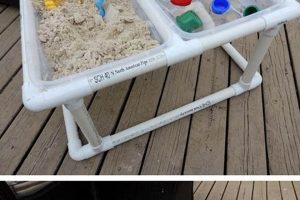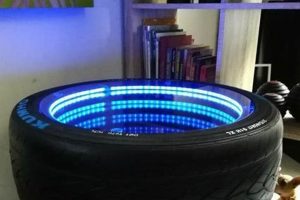A self-constructed aquatic play station allows for sensory exploration and creative engagement with water. These installations often involve repurposing existing containers like plastic bins or troughs and modifying them to suit a child’s height and play preferences. An example is adapting a storage tote with added accessories such as pipes, funnels, and toy boats.
Such constructions offer numerous advantages, including promoting tactile learning, encouraging imaginative play, and providing a constructive outlet for energy. Historically, similar water-based play areas have existed in rudimentary forms, emphasizing the enduring appeal of water as a medium for learning and recreation. These projects can foster collaborative skills if multiple children are involved in their construction or use.
The following sections will detail various designs for these aquatic play environments, exploring different materials, construction techniques, and potential modifications to enhance the user experience. Guidance will also be provided on safety considerations and appropriate age-specific adaptations.
Construction Guidance
The following are recommendations for building an engaging and safe aquatic play area:
Tip 1: Material Selection: Opt for non-toxic, durable plastics or treated wood suitable for outdoor use. This minimizes the risk of leaching harmful chemicals and ensures longevity.
Tip 2: Structural Integrity: Reinforce the base to prevent collapse when filled with water. Consider adding legs or a sturdy frame to elevate the play surface to an appropriate height for children.
Tip 3: Water Drainage: Incorporate a drainage system, such as a plug or valve, for easy water removal. This aids in cleaning and prevents stagnant water buildup.
Tip 4: Smooth Edges: Sand down all edges and corners to prevent accidental cuts or scrapes. Consider applying edge banding for added protection.
Tip 5: Accessory Integration: Add various interactive elements such as pipes, funnels, and scoops to stimulate creative play. Secure these elements firmly to prevent detachment.
Tip 6: Location Considerations: Position the station on a level surface in an area with good drainage to prevent water accumulation around the play area.
Tip 7: Supervision Imperative: Constant adult supervision is essential while the play area is in use to prevent accidents and ensure safe interaction with water.
Adhering to these suggestions will result in a safe, engaging, and durable aquatic play station that promotes creativity and tactile learning. Prioritizing material selection, structural integrity, and safety features are paramount for a successful build.
The following sections will explore design variations and advanced construction techniques for customizing the aquatic play area to meet specific needs and preferences.
1. Material Safety
The selection of materials for a self-constructed aquatic play area is paramount, directly influencing the safety and health of users. Material composition dictates potential risks of chemical leaching, physical harm from sharp edges or splinters, and the overall durability of the structure. For example, untreated wood can splinter, posing a laceration hazard, while certain plastics may degrade under prolonged exposure to sunlight and water, releasing harmful chemicals. The consequence of neglecting material safety can range from minor skin irritation to more severe health complications, particularly in young children who are prone to mouthing objects.
Prioritizing non-toxic, food-grade plastics, sealed and treated wood, and rust-resistant metals mitigates these risks. Furthermore, ensuring all surfaces are smooth and free of sharp edges is critical in preventing accidental injuries. Consider, for instance, using a polyethylene plastic bin, commonly used for food storage, as the primary container, and sealing any wooden components with a non-toxic sealant specifically designed for outdoor use. Regularly inspecting the play area for signs of degradation, such as cracking or peeling, is also essential for maintaining a safe play environment.
In summary, material selection is not merely a construction detail but a fundamental safety imperative in creating a functional and enjoyable aquatic play space. Neglecting this aspect undermines the inherent benefits of a self-constructed environment, highlighting the necessity of informed material choices and diligent maintenance. The challenge lies in balancing affordability and accessibility with safety considerations, underscoring the need for thorough research and careful selection of appropriate materials.
2. Structural Stability
Structural stability is a paramount consideration in the design and construction of self-constructed aquatic play areas. It directly impacts the safety and longevity of the installation, ensuring it can withstand the weight of water and the stresses of regular use without risk of collapse or failure.
- Material Load Capacity
The inherent load-bearing capacity of the chosen construction materials dictates the maximum water volume the structure can safely hold. For instance, thin-walled plastic bins may buckle under the weight of several gallons of water, necessitating reinforcement. Similarly, insufficiently treated wood can warp or rot, compromising structural integrity. Calculating load-bearing capacity and selecting materials with appropriate strength is essential.
- Joint Integrity
The strength and integrity of joints are critical for maintaining structural stability. Weak or poorly constructed joints, whether using screws, adhesives, or other fastening methods, can become points of failure. For example, a butt joint secured only with glue may not withstand prolonged exposure to moisture and stress, whereas a reinforced joint with mechanical fasteners and waterproof adhesive provides greater stability. Properly engineered and executed joints are fundamental to the overall stability of the unit.
- Base Support and Distribution
The base of the aquatic play area must provide adequate support and distribute the weight evenly to prevent localized stress and potential collapse. Uneven weight distribution can lead to tipping or structural damage, particularly on uneven surfaces. Utilizing a wide, stable base, such as a reinforced frame or multiple support legs, is crucial for distributing the load and ensuring overall stability. The base’s design directly contributes to the unit’s ability to remain upright and intact under load.
- Environmental Factors
External environmental factors, such as wind, sunlight, and temperature fluctuations, can influence structural stability. High winds can exert significant force on the structure, potentially causing it to tip over. Prolonged exposure to sunlight can degrade certain materials, reducing their strength. Fluctuations in temperature can cause expansion and contraction, stressing joints and fasteners. Accounting for these factors through appropriate material selection, weatherproofing, and secure anchoring is essential for long-term structural integrity.
In conclusion, structural stability in the context of self-constructed aquatic play areas is a multifaceted concern involving material properties, joint construction, base support, and environmental considerations. A comprehensive approach to these factors ensures a safe, durable, and enjoyable play environment for children. Neglecting any of these aspects compromises the overall integrity of the installation, potentially leading to safety hazards and premature failure. Diligent planning and careful execution are essential for achieving a structurally sound and reliable aquatic play area.
3. Ergonomic Design
Ergonomic design, the practice of designing products and environments to fit the people who use them, is of paramount importance in the creation of a self-constructed aquatic play area. Optimizing the interaction between the child and the play station ensures safety, comfort, and maximizes developmental benefits. Failure to address ergonomic considerations can lead to discomfort, strain, and reduced engagement.
- Height and Reach Considerations
The height of the water table and the reach required to access its various components must be tailored to the user’s size and developmental stage. A table that is too high will be inaccessible, while one that is too low can promote slouching and strain. The ideal height allows the child to stand comfortably with arms at a natural angle. For instance, a water table for a toddler may be 16-20 inches high, while one for a preschooler may be 20-24 inches. Furthermore, the placement of accessories should allow for easy reach without excessive stretching or bending.
- Accessibility and Inclusivity
Ergonomic design should consider accessibility for children with diverse abilities. The design should accommodate children who may use mobility aids, have limited range of motion, or sensory sensitivities. For example, ensuring sufficient space around the table for wheelchair access, providing textured surfaces for tactile exploration, and minimizing sharp edges are crucial. Universal design principles should be incorporated to create an inclusive and engaging play experience for all users. Considerations could be adding handles to support standing and reducing water splashing for sensory-sensitive children.
- Weight and Stability
The weight of the water table, both empty and filled, and its stability are important ergonomic factors. A lightweight table may be easily tipped over, posing a safety hazard, while an excessively heavy table can be difficult to move and clean. The design should balance stability with maneuverability, ensuring that the table is both safe and practical. Furthermore, the materials used should be durable enough to withstand repeated use and exposure to water without compromising structural integrity. Ensuring a wide base can also add to the stability.
- Component Design and Functionality
The design of individual components, such as water wheels, funnels, and scoops, should also be ergonomically sound. These components should be sized appropriately for small hands, easy to grip, and intuitive to use. Sharp edges, small parts that pose a choking hazard, and complex mechanisms should be avoided. The functionality of each component should be clear and easily understood, promoting independent exploration and problem-solving. For example, a scoop with a comfortable handle and a clearly defined pouring spout is more ergonomic than a generic cup.
The foregoing facets illustrate the interconnectedness of ergonomic principles and the practical design of a self-constructed aquatic play area. Attention to height, accessibility, weight, and component functionality contributes to a safe, comfortable, and developmentally enriching play experience. Neglecting ergonomic considerations can diminish the benefits of the play station, potentially leading to discomfort, frustration, and reduced engagement. Thoughtful application of ergonomic design principles transforms a simple water table into a valuable tool for learning and exploration.
4. Sensory Enrichment
Sensory enrichment, a critical component in early childhood development, is readily facilitated through the design and utilization of self-constructed aquatic play stations. These installations provide opportunities for children to engage with a variety of sensory stimuli, fostering cognitive and physical growth. The ability to customize these stations enhances their potential for tailored sensory experiences.
- Tactile Stimulation
Tactile stimulation is achieved through interaction with water and diverse materials incorporated into the station. Children experience varying textures, temperatures, and pressures, stimulating tactile receptors in their skin. Examples include smooth stones, rough sponges, and flowing water, each providing unique tactile input. This sensory input is crucial for developing fine motor skills and enhancing body awareness.
- Auditory Input
Auditory input is generated by the sound of water flowing, splashing, and interacting with different objects. The soundscapes created by water moving through pipes, funnels, and other accessories offer auditory stimulation. This auditory enrichment can improve auditory processing skills and foster an understanding of cause-and-effect relationships. Varying the water flow rate and the materials it interacts with creates a diverse auditory environment.
- Visual Engagement
Visual engagement is enhanced through the incorporation of colorful objects, transparent containers, and moving water. The visual stimulation provided by these elements can improve visual tracking skills, color recognition, and spatial awareness. For example, adding colored dyes to the water or including clear tubes that allow children to observe water flowing through them enhances visual interest and engagement.
- Proprioceptive Awareness
Proprioceptive awareness, the sense of body position and movement, is fostered through activities such as pouring, lifting, and manipulating objects within the aquatic play station. These actions require children to coordinate their movements and exert varying levels of force, stimulating proprioceptors in their muscles and joints. This enhanced proprioceptive input can improve motor skills, coordination, and body awareness.
In essence, the self-constructed aquatic play station serves as a versatile platform for sensory enrichment, offering a multitude of opportunities for children to engage with diverse sensory stimuli. The customizability of these stations allows for tailoring the sensory experience to meet individual needs and preferences, maximizing the developmental benefits. The integration of tactile, auditory, visual, and proprioceptive elements creates a rich sensory environment that promotes cognitive, physical, and emotional growth.
5. Drainage Efficiency
Effective water removal from a self-constructed aquatic play station is crucial for maintaining hygiene, preventing material degradation, and ensuring long-term usability. Adequately managing water drainage mitigates potential health risks and extends the lifespan of the structure.
- Hygiene Maintenance
Stagnant water within aquatic play areas can become a breeding ground for bacteria, algae, and other microorganisms, posing a health risk to children. Efficient drainage allows for the regular emptying and cleaning of the station, preventing the accumulation of contaminants. For example, a system that enables complete water removal after each use minimizes the potential for microbial growth and associated health concerns.
- Material Preservation
Prolonged exposure to water can degrade certain materials used in the construction of aquatic play stations, leading to warping, rotting, or corrosion. Effective drainage minimizes the contact time between water and susceptible materials, extending the lifespan of the structure. The implementation of a drainage system that allows for complete water removal can significantly reduce the rate of material degradation.
- Pest Control
Standing water is an attractive breeding ground for mosquitoes and other insects, posing a nuisance and potential health hazard. Implementing a drainage system that prevents water accumulation eliminates this breeding ground, reducing the risk of insect infestations. Features include a tightly sealing drainage valve or a design that allows the station to be completely inverted for emptying.
- Ease of Maintenance
A well-designed drainage system simplifies the process of cleaning and maintaining the aquatic play station. Systems that allow for quick and easy water removal encourage regular maintenance, preventing the buildup of dirt, debris, and contaminants. Features such as conveniently located drainage plugs or integrated drainage channels streamline the maintenance process and enhance user convenience.
The foregoing emphasizes the symbiotic relationship between drainage efficiency and the overall functionality and longevity of a self-constructed aquatic play environment. Integrating a comprehensive drainage strategy from the outset of the design phase is crucial for ensuring hygiene, preserving materials, controlling pests, and simplifying maintenance. The result is a safer, more durable, and more enjoyable play experience for children.
6. Continuous Supervision
The presence of an adult supervising a child’s engagement with a self-constructed aquatic play area is non-negotiable. This precaution is paramount for mitigating inherent risks associated with water play and ensuring a safe, enriching experience.
- Drowning Prevention
The potential for drowning, even in shallow water, necessitates constant vigilance. Children can be submerged in a matter of seconds, emphasizing the critical need for an adult to be within arm’s reach. This measure is especially important for children with limited swimming abilities or pre-existing medical conditions that may increase their risk. Furthermore, vigilance helps address unexpected events, such as slips or falls within the play area.
- Hazard Identification and Mitigation
Self-constructed aquatic play areas may present unforeseen hazards that require immediate attention. These hazards can include loose components, sharp edges, or the presence of foreign objects in the water. A supervising adult can promptly identify and address these risks, preventing potential injuries. Regular inspection of the play area before and during use is an essential component of effective supervision.
- Ensuring Safe Play Practices
Supervision ensures that children engage in safe play practices, such as avoiding roughhousing near the water, preventing the ingestion of water, and using accessories appropriately. A supervising adult can provide guidance and redirection, teaching children about safe interactions with water and promoting responsible behavior. This can also involve setting clear boundaries and rules regarding play within and around the aquatic station.
- Facilitating Learning and Exploration
Beyond safety, supervision facilitates learning and exploration by providing opportunities for interaction and guidance. A supervising adult can encourage children to experiment, ask questions, and explore the properties of water. This interaction promotes cognitive development and enhances the learning experience. This engagement can also involve introducing new vocabulary related to water, physics, or nature.
The integration of continuous supervision with self-constructed aquatic play areas is not merely a safety precaution but also an opportunity to foster cognitive development, teach safe play practices, and create a richer learning environment. A vigilant adult transforms a simple water play activity into a valuable educational experience while significantly reducing the risk of accidents or injuries.
Frequently Asked Questions
The following section addresses common inquiries regarding the design, construction, and maintenance of self-constructed aquatic play environments.
Question 1: What are the essential safety considerations when constructing an aquatic play area?
Safety imperatives include using non-toxic materials, ensuring structural stability, eliminating sharp edges, implementing effective drainage, and providing continuous adult supervision during use.
Question 2: What materials are most suitable for building a durable and safe aquatic play station?
Recommended materials encompass food-grade plastics, treated and sealed wood designed for outdoor use, and rust-resistant metals. All materials should be free of sharp edges and potential contaminants.
Question 3: How can structural stability be ensured in a self-constructed aquatic play structure?
Structural integrity is achieved through robust joint construction, adequate base support, and selecting materials with sufficient load-bearing capacity to withstand the weight of water and intended use.
Question 4: What ergonomic factors should be considered when designing an aquatic play area?
Ergonomic considerations encompass the height and reach requirements of the user, accessibility for individuals with diverse abilities, and the weight and stability of the overall structure to prevent tipping or strain.
Question 5: How can sensory enrichment be incorporated into an aquatic play station?
Sensory enrichment can be achieved through the inclusion of diverse textures, colors, sounds, and opportunities for proprioceptive movement. Accessories such as water wheels, funnels, and textured materials enhance sensory engagement.
Question 6: What drainage mechanisms are most effective for managing water removal in an aquatic play area?
Effective drainage mechanisms encompass strategically placed drainage plugs, integrated drainage channels, or designs that allow for complete inversion of the structure. Efficient drainage prevents water accumulation, promoting hygiene and material preservation.
In summary, prioritizing safety, material selection, structural stability, ergonomic design, sensory enrichment, and drainage efficiency is crucial for creating a functional and beneficial aquatic play area. Each aspect contributes to the overall user experience and ensures a safe and stimulating environment.
The subsequent segment will explore design variations and advanced construction methodologies for optimizing the functionality and aesthetics of these play installations.
DIY Water Table
This exploration has emphasized multifaceted considerations inherent in crafting a beneficial aquatic play environment. The “diy water table,” while seemingly straightforward, necessitates careful attention to material safety, structural integrity, ergonomic design, sensory enrichment, drainage efficiency, and the unwavering commitment to continuous supervision. These elements collectively define the difference between a potentially hazardous construct and a valuable developmental tool.
The successful implementation of these principles ensures not only the immediate safety and enjoyment of the child but also fosters a foundation for learning and exploration. Further investment in innovative designs and responsible construction practices will undoubtedly elevate the “diy water table” beyond a mere pastime, solidifying its position as a significant contributor to early childhood education and sensory development. Continued research and responsible application of the outlined principles are essential to maximize the benefits and minimize the risks associated with this engaging play medium.







